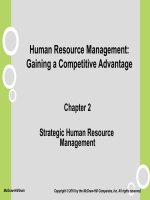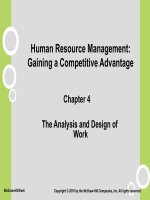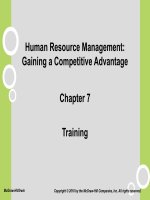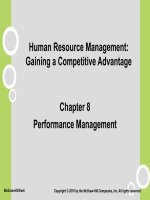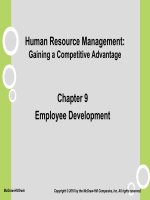HRM gaining a competitive advantage noe ch004
Bạn đang xem bản rút gọn của tài liệu. Xem và tải ngay bản đầy đủ của tài liệu tại đây (250.42 KB, 23 trang )
Human Resource Management:
Gaining a Competitive Advantage
Chapter 4
The Analysis and Design of
Work
McGraw-Hill/Irwin
Copyright © 2010 by the McGraw-Hill Companies, Inc. All rights reserved.
Learning Objectives
1. Analyze an organization’s structure and work flow
process, identifying the output, activities and inputs in the
production of a product or service.
2. Understand the importance of job analysis in strategic
and human resource management.
3. Choose the right job analysis technique for a variety of
human resource activities.
4. Identify the tasks performed and the skills required in a
given job.
5. Understand the different approaches to job design.
6. Comprehend the trade-offs among the various
approaches to designing jobs.
4-2
Work-flow Design
Work-flow design is the process of
analyzing the tasks necessary for the
production of a product or service, prior to
allocating and assigning these tasks to a
particular job category or person.
Organization structure refers to the
relatively stable and formal network of
vertical and horizontal interconnections
among jobs that constitute the
organization.
4-3
Work-flow Analysis
Work-flow analysis are useful in providing:
– a means for the managers to understand all the
tasks required to produce a high-quality product
– the skills necessary to perform those tasks
Work flow analysis includes analyzing:
– work outputs
– work processes
– work inputs
4-4
Developing a Work-unit Activity
4-5
Organizational Structure
Organization structure provides a crosssectional overview of the static relationship
between individuals and units that create
the outputs.
Two important dimensions of structure are:
1. Centralization
2. Departmentalization
4-6
Structural Configuration
Functional
Functional
•• functional
functional
departmentalization
departmentalization
•• high
highlevel
levelof
ofcentralization
centralization
•• high
highefficiency
efficiency
•• inflexible
inflexible
•• insensitive
insensitiveto
tosubtle
subtle
differences
differencesacross
across
products,
products,regions
regionsand
and
clients
clients
Divisional
• workflow
departmentalization
• low level of centralization
• semi-autonomous
• flexible and innovative
• sensitive to subtle
differences across products,
regions and clients
4-7
Importance of Job Analysis to HR Managers
Work
Work Redesign
Redesign
Performance
Performance Appraisal
Appraisal
HR
HR Planning
Planning
Training
Training && Development
Development
Selection
Selection
Career
Career Planning
Planning
Job
Job Evaluation
Evaluation
Job
Job Analysis
Analysis
Job
Job Analysis
Analysis
4-8
Job Analysis Information
Job
Job Description
Description Job Specification
is
is aa list
list of
of tasks,
tasks,
duties,
duties, and
and
responsibilities
responsibilities
(TDRs)
(TDRs) tasks,
tasks,
duties
duties and
and
responsibilities.
responsibilities.
is a list of skills,
knowledge, abilities,
and other
characteristics
(KSAOs) knowledge,
skills, abilities and
other characteristics.
4-9
Sample Job Description
Job Title: Maintenance Mechanic
General Description of Job: General maintenance and
repair of all equipment used in the operations of a
particular district. Includes the servicing of company
used vehicles, shop equipment, and machinery used on
job sites.
1. Essential duty (40%) Maintenance of Equipment
2. Essential duty (40%) Repair of Equipment
3. Essential duty (10%) Testing and Approval
4. Essential duty (10%) Maintain Stock
Nonessential functions: Other duties assigned
4-10
Job Analysis Methods
Job
JobAnalysisAnalysis-process
processof
of getting
gettingdetailed
detailed
information
informationabout
aboutjobs.
jobs.
4-11
Overall Dimensions of the
Position Analysis Questionnaire
Decision/communication/general responsibilities
Clerical/related activities
Technical/related activities
Service/related activities
Regular day schedule versus other work schedules
Routine/repetitive work activities
Environmental awareness
General physical activities
Supervising/coordinating other personnel
Public/customer/related contact activities
Unpleasant/hazardous/demanding environment
Non-typical work schedules
4-12
Job Design and Job Redesign
Job
Job design
design is
is the
the
process
process of
of defining
defining
how
how work
work will
will be
be
performed
performed and
and the
the
tasks
tasks that
that
will
will be
be required
required in
in aa
given
given job.
job.
Job redesign
refers to
changing the
tasks or the
way work is
performed in an
existing job.
4-13
Job Design – Job Redesign
Four Approaches Used in Job Design
Mechanistic
Mechanistic
Motivational
Motivational
Biological
Biological
Perceptual-motor
Perceptual-motor
4-14
Approaches to Job Design
The mechanistic approach
Specialization
Skill variety
Work methods autonomy
The motivational approach
Decision-making autonomy
Task significance
Interdependence
The biological approach
Physical demands
Ergonomics
Work conditions
The perceptual approach
Job complexity
Information processing
Equipment use
4-15
Mechanistic Approach
Has its roots in classical industrial engineering.
It focuses on identifying the simplest way to
structure work that maximizes efficiency by
designing jobs around three concepts:
– task specialization
– skill simplification
– repetition
Scientific management
– is one of the earliest mechanistic approaches
– sought to identify the one best way to perform the
job through the use of time-and-motion studies
4-16
Motivational Approach
Focuses on the job characteristics that affects
– the psychological meaning
– motivational potential of job design.
A focus on increasing job complexity through:
– job enlargement
– job enrichment
– the construction of jobs around sociotechnical
systems.
4-17
Job Characteristics Model
A model of how job design affects employee reaction
Work Outcomes
High Quality of Work
High Satisfaction
Low Turnover and
Absenteeism
4-18
Biological Approach
Comes primarily from the sciences of
biomechanics, or the study of body
movements
Ergonomics- the goal of this approach is to
minimize the physical strain on the worker.
Focuses on outcomes such as:
– physical fatigue
– aches and pains
– health complaints
4-19
Perceptual-Motor Approach
•Has its roots in the human-factors literature.
•Focuses on human mental capabilities and
limitations.
•The goal is to design jobs that do not exceed
people's mental capabilities.
•Tries to improve reliability, safety, and user
reactions by designing jobs in a way that
reduces the information processing
requirements of the job.
4-20
The Importance of Job
Analysis to Line Managers
1. Managers must have detailed
information about all the jobs in their
work group to understand the workflow process.
2. Managers need to understand the job
requirements to make intelligent hiring
decisions.
3. Managers must clearly understand
the tasks required in every job.
4-21
Trade-Offs Among Different Approaches to Job Design
Approach
Positive Outcomes
Negative Outcomes
Motivational
Higher job satisfaction
Increased training time
Lower utilization levels
Greater likelihood of error
Greater chance of mental
overload
and stress
Higher motivation
Greater job involvement
Lower absenteeism
Mechanistic
Biological
PerceptualMotor
Decreased training time
Higher utilization levels
Lower likelihood of
error
Less chance of mental
overload and stress
Less physical effort
Less physical fatigue
Fewer health complaints
Fewer medical
incidences
Lower absenteeism
Higher job satisfaction
Lower likelihood of
error
Lower likelihood of
accidents
Less chance of mental
overload and stress
Lower training time
Higher utilization levels
Lower job satisfaction
Lower motivation
Higher absenteeism
Higher financial costs because
of changes in equipment or
job environment
Lower job satisfaction
Lower motivation
4-22
Summary
Job analysis and design is one of the most
important components to develop and maintain a
competitive advantage and implement strategy.
Managers need to understand the entire work-flow
process to ensure efficiency and effectiveness and
have clear, detailed information about the jobs.
Managers can redesign jobs to ensure that the
work unit is able to achieve its goals while individuals
benefit from as motivation, satisfaction, safety, health
and achievement.
4-23

